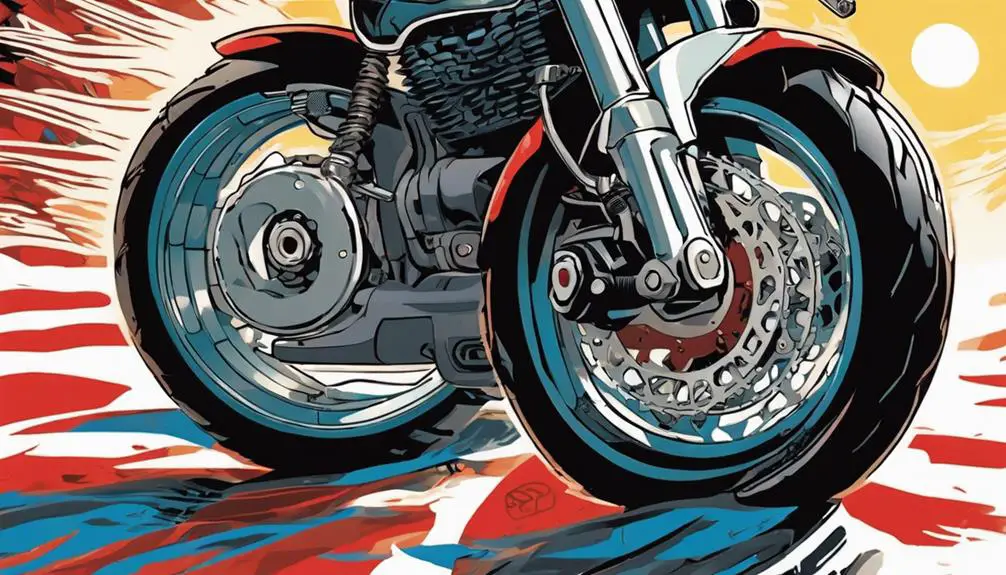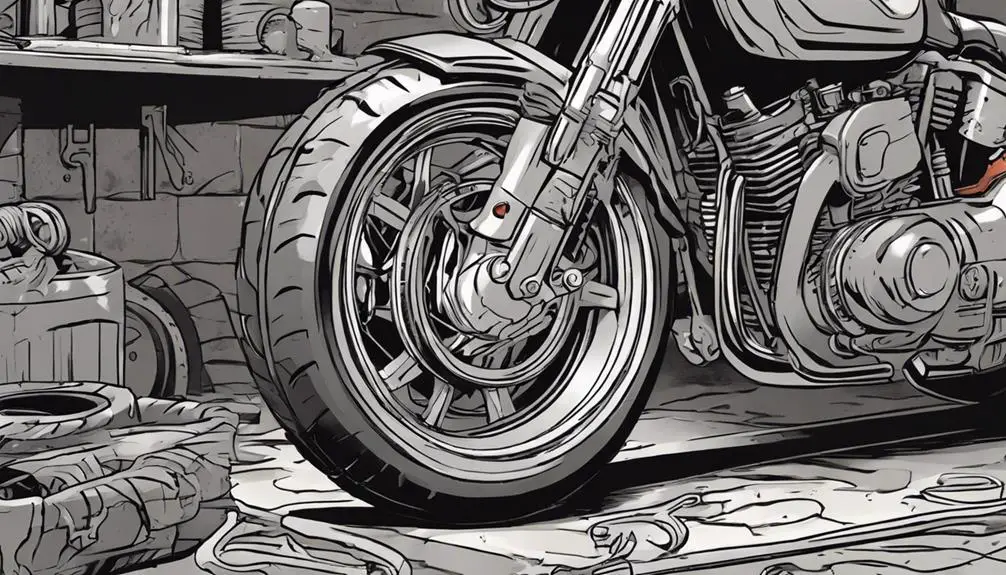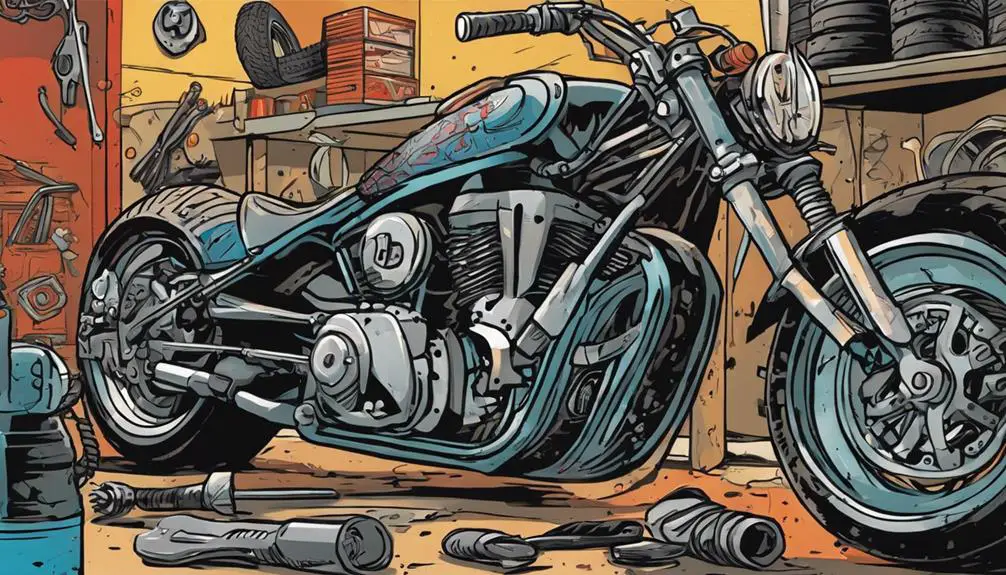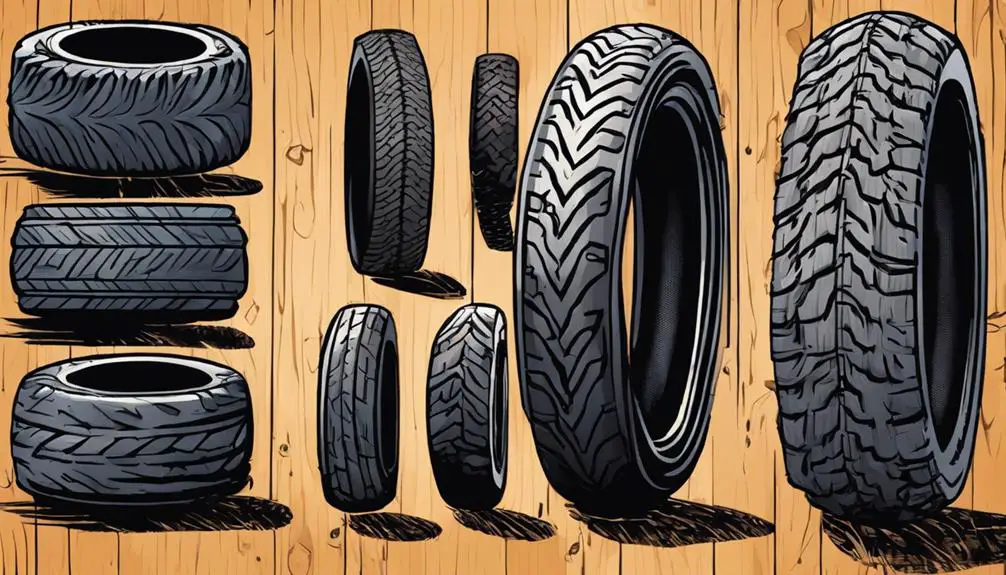When you ride, you may not think much about how your tires wear, but understanding those patterns can make a big difference in your motorcycle's performance. Whether you're noticing center wear, edge wear, or even cup wear, these issues can stem from various factors like improper inflation or riding style. By diagnosing the underlying causes, you can implement effective solutions to enhance both safety and enjoyment. Curious about the best maintenance tips and how your riding habits impact tire longevity? There's much more to explore.
Key Takeaways
- Common tire wear patterns include center wear, edge wear, cup wear, and flat spotting, each indicating specific issues with tire maintenance or riding habits.
- Causes of tire wear often stem from improper inflation, misalignment, aggressive riding, and poor road conditions, affecting tire longevity and performance.
- Diagnosing tire wear issues involves checking for uneven tread wear, bald spots, cracks, and unusual vibrations for timely intervention.
- Solutions for tire problems include adjusting tire pressure, repairing punctures, balancing wheels, and selecting appropriate tires based on riding style and terrain.
Overview of Ducati Motorcycle Tires

Ducati motorcycle tires are designed to enhance performance, providing riders with the grip and stability they need on various terrains. When you hop on your Ducati, you're not just riding; you're embracing freedom. The right tires empower you to conquer winding roads and open highways alike, allowing you to feel the thrill of the ride.
These tires come with advanced rubber compounds that maximize traction, ensuring your bike responds precisely when you lean into a turn or accelerate. You'll notice how the unique tread patterns effectively channel water away, boosting your confidence in wet conditions. Whether you're cruising along the coast or tackling a challenging mountain pass, Ducati tires are engineered to make every ride exhilarating.
You'll appreciate the balance between durability and performance, as these tires are built to withstand the demands of spirited riding. With Ducati, you're not just choosing tires; you're choosing an experience that elevates your journey.
Common Tire Wear Patterns
Understanding common tire wear patterns is essential for maintaining your motorcycle's performance and safety on the road. Recognizing these patterns helps you stay in tune with your ride and guarantees that you're prepared for any adventure.
Here are four common tire wear patterns you might encounter:
- Center Wear: This happens when the tire's center wears down faster than the edges, often due to over-inflation. It can lead to reduced grip and stability.
- Edge Wear: If the edges of your tire wear more than the center, it's likely a sign of under-inflation or aggressive cornering. This can compromise your handling on curves.
- Cup Wear: Look for a wavy pattern on your tire tread. This irregular wear can indicate issues with suspension or alignment, affecting your bike's smoothness.
- Flat Spotting: If you notice a flat area on the tire, it's usually from sudden braking or prolonged stops. This can affect your balance and control.
Causes of Tire Wear

Tire wear on your motorcycle can stem from various factors, including improper inflation, misalignment, and riding habits.
When you ride with under-inflated or over-inflated tires, you compromise grip and control, leading to uneven wear. It's essential to check your tire pressure regularly to guarantee you're riding with the right inflation.
Misalignment, whether it's from an accident or poor maintenance, can also cause tires to wear unevenly. If your wheels aren't aligned, you might feel your bike pulling to one side, which contributes to a shorter tire lifespan.
Your riding habits play a significant role too. Aggressive acceleration, hard braking, and sharp turns can wear tires faster than smooth, controlled riding. Remember, riding freely doesn't mean you can ignore your tires.
Additionally, the type of roads you ride on matters. Rough surfaces and potholes can create more wear and tear. Embrace the open road, but be mindful of its conditions.
Diagnosing Wear Issues
Detecting wear issues on your motorcycle tires is essential for maintaining safety and performance on the road. When you hit the pavement, you want to feel that freedom and confidence, not worry about your tires.
Here are four key indicators to help you diagnose any wear issues:
- Uneven Tread Wear: Check for differences in tread depth across the tire. If one side is considerably more worn, it might signal alignment issues.
- Bald Spots: Look for patches where the tread has worn down to the casing. This indicates excessive wear and can lead to blowouts.
- Cracks or Bulges: Inspect the sidewalls for any signs of damage. Cracks or bulges can compromise the tire's integrity and lead to dangerous situations.
- Vibration or Noise: Pay attention to how your bike feels and sounds while riding. Unusual vibrations or noise can be warning signs of deeper issues.
Solutions for Tire Problems

When you encounter tire problems, taking immediate action can prevent further issues and keep you safe on the road.
First, assess the situation. If you notice uneven wear, check your tire pressure—it might be lower than it should be. Adjusting it can enhance performance and prolong your ride.
If you spot a puncture, don't ignore it. Depending on the size and location, you may be able to repair it with a plug kit. However, if the damage is severe, replacing the tire is your best bet. You want to maintain control of your bike, after all.
For vibrations or pulling sensations, it's essential to have your wheels balanced and aligned. This not only improves handling but also prevents premature tire wear.
Lastly, consider the type of riding you do. Choose tires that align with your needs, whether you're hitting the open road or tackling rugged trails.
Maintenance Tips for Longevity
To keep your motorcycle tires in top shape, regular inspections are essential.
You should also guarantee proper inflation levels and check for balanced wheel alignment.
These simple maintenance tips can greatly extend the life of your tires and enhance your riding experience.
Regular Tire Inspections
Regular tire inspections help guarantee your motorcycle remains safe and performs at its finest on the road. By checking your tires regularly, you can spot issues before they lead to bigger problems, allowing you to ride with confidence and freedom. Here's how to conduct effective inspections:
- Visual Check: Examine the tire tread for wear patterns, cracks, or foreign objects. Look for any uneven wear that might signal alignment issues.
- Tread Depth: Use a tread depth gauge or the penny test. If you can see all of Lincoln's head, it's time for new tires. Adequate tread ensures excellent grip.
- Sidewall Inspection: Check the sidewalls for bulges or cuts. Damage here can lead to blowouts, so don't overlook this area.
- Check for Vibration: While riding, pay attention to any unusual vibrations. This could indicate a tire imbalance or misalignment that needs addressing.
Proper Inflation Levels
Maintaining proper inflation levels is essential for maximizing tire life and guaranteeing peak performance on your motorcycle. When your tires are inflated to the correct pressure, you're not just enhancing their longevity; you're also improving handling, stability, and fuel efficiency. It's all about liberation—freedom on the road without the worry of premature tire wear.
To get started, check your tire pressure regularly, ideally before every ride. Use a reliable gauge to guarantee accuracy. Remember, tire pressure can fluctuate with temperature changes, so adjust accordingly. If you're unsure about the recommended pressure, consult your motorcycle's manual or the sticker located on the bike.
Under-inflated tires can lead to excessive heat buildup and uneven wear, while over-inflated tires can compromise grip and control. Aim for that sweet spot where performance meets safety.
Also, don't forget to inspect your tires for any signs of wear or damage during these checks.
Balanced Wheel Alignment
Balanced wheel alignment plays an essential role in extending the life of your motorcycle tires and guaranteeing ideal handling on the road.
When your wheels are aligned correctly, you'll experience improved stability, better fuel efficiency, and reduced tire wear.
To maintain balanced wheel alignment and enjoy a smoother ride, follow these key maintenance tips:
- Regular Inspections: Check your alignment regularly, especially after hitting potholes or curbs. Look for uneven tire wear or pulling to one side.
- Professional Alignment: Schedule a professional alignment service if you notice any discrepancies. Mechanics have the tools and expertise to get it right.
- Adjust Suspension: Confirm your motorcycle's suspension is properly adjusted. A well-tuned suspension can greatly impact alignment.
- Tire Rotation: Rotate your tires regularly to promote even wear. This keeps your tires balanced and extends their lifespan.
Choosing the Right Tires

When you're choosing the right tires for your motorcycle, consider the different types available and how they match your riding style.
Your choice will also depend on the weather conditions you typically face, as these can greatly affect performance.
Let's break down these key factors to help you make an informed decision.
Tire Types Overview
Choosing the right tires for your motorcycle is essential for optimizing performance and safety on the road. With so many options available, it's vital to understand the different types of tires suited for your ride. Here's a concise breakdown to guide your decision:
- Sport Tires: Designed for speed and grip, these tires excel in handling and cornering on paved surfaces. They're perfect for thrill-seekers who crave agility.
- Cruiser Tires: Built for comfort and stability, these tires offer a smooth ride over long distances. Ideal for those who enjoy leisurely journeys and want to soak in the scenery.
- Adventure Tires: If you're someone who loves exploring off-road terrains, these tires provide versatility. They balance grip on both dirt and pavement, catering to your adventurous spirit.
- Touring Tires: Perfect for long-distance travel, these tires prioritize durability and comfort. They provide a smooth ride, making them ideal for those liberating cross-country journeys.
Riding Style Considerations
Understanding your riding style is essential for selecting tires that enhance your motorcycle's performance and safety.
Whether you're a spirited rider seeking thrills on twisty roads or a laid-back cruiser enjoying the open highway, your tire choice should align with your unique rhythm and preferences.
If you lean towards aggressive cornering and quick maneuvers, opt for sport tires. They offer better grip and responsiveness, allowing you to unleash your bike's full potential.
On the other hand, if you prefer long-distance journeys or commuting, touring tires can provide comfort and durability, ensuring you glide smoothly over miles without sacrificing stability.
For those who embrace adventure and off-road trails, dual-sport tires combine versatility and traction, letting you explore diverse terrains with confidence.
Remember, your tires are the only contact between you and the road, so choose wisely.
Ultimately, understanding your riding style isn't just about performance; it's about freedom.
The right tires will empower you to ride with passion and liberty, whether you're carving through canyons or cruising down coastal highways.
Weather Conditions Impact
Your riding experience can considerably change based on weather conditions, making it important to select tires that perform well in various climates. Choosing the right tires for the weather isn't just about grip; it's about enhancing your freedom on the road. Here are some key factors to reflect upon:
- Wet Conditions: Opt for tires with deeper tread patterns and softer compounds to improve traction and reduce hydroplaning.
- Cold Weather: Select tires designed for lower temperatures, as they remain flexible and provide better grip, even when the asphalt is chilly.
- Hot Conditions: Choose tires with heat-resistant compounds that can withstand high temperatures without compromising performance or safety.
- Mixed Weather: Contemplate all-weather tires that balance performance for both dry and wet conditions, allowing you to ride with confidence no matter what Mother Nature throws at you.
Impact of Riding Style
Riding style significantly influences tire wear patterns, with aggressive maneuvers leading to quicker degradation compared to smoother, more controlled techniques.
When you push your motorcycle to the limits—leaning hard into corners and accelerating sharply—you're likely to see uneven wear on your tires. This can compromise not just performance but also your safety.
On the flip side, if you adopt a more relaxed, fluid riding approach, you'll enjoy a longer tire lifespan. Embracing this style allows you to revel in the freedom of the open road while also caring for your machine. You're not just riding; you're crafting an experience.
Think about how you can adjust your throttle control and cornering technique. Smooth acceleration and gentle braking can extend your tire's life while enhancing your overall ride. You'll feel the difference, and your bike will thank you.
Ultimately, it's about finding that balance between exhilaration and longevity. By being mindful of your riding style, you can enjoy the thrill of the ride without sacrificing the wear and tear on your tires.
Embrace the freedom of the road, but do it with an awareness that leads to better performance.
Frequently Asked Questions
How Do Weather Conditions Affect Motorcycle Tire Wear?
Weather conditions can greatly impact your motorcycle's tire wear.
When it rains, tires can wear unevenly due to reduced traction and increased slipping.
In hot weather, tires can overheat, leading to faster degradation.
Cold temperatures can harden the rubber, affecting grip and wear patterns.
You'll want to adjust your riding style and tire pressure accordingly.
Staying aware of how the elements affect your ride can help you maintain better control and prolong your tires' lifespan.
Can Tire Pressure Influence Wear Patterns Significantly?
Did you know that riding with just 10% under-inflated tires can reduce their lifespan by up to 15%?
Keeping your tire pressure at the ideal level isn't just about safety; it's also about liberating your ride.
When your tires are properly inflated, they wear evenly, giving you better grip and control.
What Are Signs of Tire Wear During a Ride?
While you're riding, keep an eye out for signs of tire wear.
Look for uneven tread, bulges, or cracks. If your bike feels shaky or pulls to one side, that's a red flag.
Listen for unusual noises too; they often signal something's off.
When you spot these signs, it's time to take action.
Trust your instincts—your ride should feel smooth and secure.
Don't ignore what your tires are telling you!
How Often Should I Inspect My Motorcycle Tires?
Imagine your tires are like a dramatic soap opera—full of twists and turns. You wouldn't want to miss a single episode, right?
So, you should inspect your motorcycle tires at least once a month. Keep an eye on tread depth and any signs of wear.
If you're planning a long ride, check 'em beforehand. After all, your freedom on the road depends on those rubber companions gripping the asphalt!
Can Riding With Worn Tires Affect Handling and Safety?
Yes, riding with worn tires can seriously affect your handling and safety. When tires lose their tread, they can't grip the road properly, making it harder for you to control your bike, especially in wet or slippery conditions.
This can lead to dangerous situations, compromising your freedom on the road. Keeping your tires in good shape isn't just about performance; it's essential for your safety and the joy of riding.
Conclusion
To guarantee peak performance and safety, stay savvy about your motorcycle's tires.
By spotting signs of wear and swiftly addressing issues, you can sidestep serious problems down the road.
Prioritize proper pressure, perfect alignment, and prudent tire selection to promote prolonged tire life.
Remember, your riding style plays a pivotal role in performance, so adapt accordingly.
With consistent care, your tires will travel triumphantly, delivering delightful rides and dynamic handling on every journey you commence.